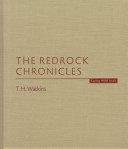Center Books on Space, Place, and Time (Hardcover)
1 total work
In The Redrock Chronicles, T. H. Watkins, one of America's best-known and award-winning writers on the environment and history, focuses on southern Utah's unprotected lands in a loving testament to its warps and tangles of rock and sky. Combining history, geography, and photography, the author reports the full story of the region -- from its violent geologic beginnings to the coming (and going) of pre-Puebloan peoples whose drawings still adorn rocks and caves there, from the Mormon settlement of the 1840s and 1850s to the great uranium boom of the 1950s, from the beginning of tourism and parkland protection in the 1930s to today's controversial movement to preserve millions of acres of wild Utah land in the National Wilderness Preservation System. Indeed, the account of that revolutionary movement is told here in all its color andcomplexity for the first time.
Writing from his own personal experience and extensive research, an appreciative Watkins takes readers on a tour of the Grand Staircase of plateaus, moving from the utterly wild triangle of Kaiparowits Plateau, with its erosion-sculptured mesas, tablelands, benchlands, and canyons, to a more welcoming kind of verdant wilderness that sits northeast, across the rolling desert scrubland of Harris Wash, in the red-walled canyon of the Escalante River. The author has spent much time hiking and camping here among the isolated buttes and mesas, and he draws a vivid portrait of the area's highlights: Comb Ridge, a 90-mile wall of 600-foot cliffs; Waterpocket Fold, an even more spectacular monocline to the northeast of the Escalante River, stretching a hundred miles; the Henry Mountains; Hump of Bull Mountain; Cataract Canyon; and the San Rafael Swell, an enormous oval some 2,200 square miles which rises just north of Capitol Reef National Park.
But The Redrock Chronicles is not simply a celebration. Watkins concludes with a spirited call for the preservation of the unprotected wilderness that gives the land its character and color. He offers the legislative device of wilderness designation as the necessary means of saving this plateau country that is not marked by one or two or even three or four scenic marvels but by an enormous kaleidoscope of geological diversity whose impact on the senses can set the mind to reeling with every turn.
